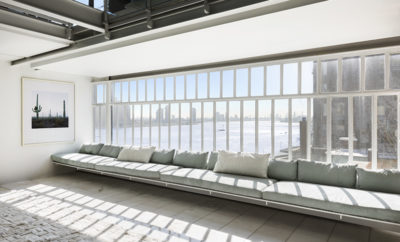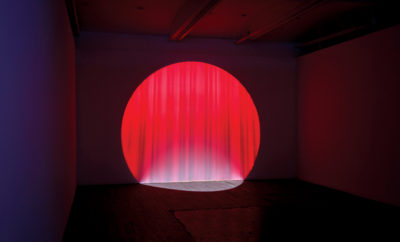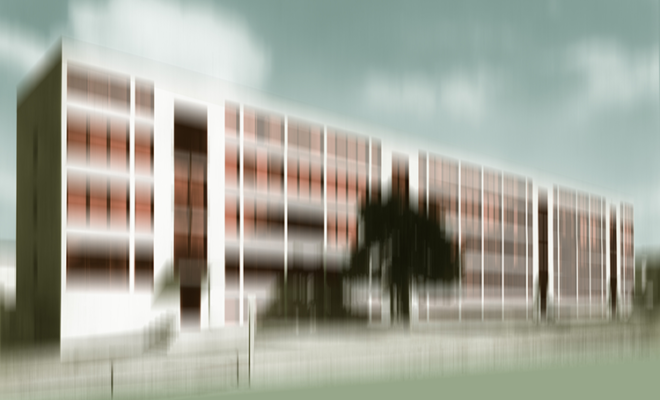 w.h.s. 10 by Thomas Ruff, 2001. Collection of George Yabu and Glenn Pushelberg. Image courtesy David Zwirner, New York/London/Hong Kong.
w.h.s. 10 by Thomas Ruff, 2001. Collection of George Yabu and Glenn Pushelberg. Image courtesy David Zwirner, New York/London/Hong Kong.
Exhibition
Ceci n’est pas une immeuble
The problem with photography, Nicholas Muellner wrote, is that “it is hard to say when we are dealing in ‘subjects’ and when we are dealing in imaginary projection.” Consider: Do we truly know Richard Neutra’s buildings or just Julius Shulman’s photographs of them? In the scheme of art history, the story of the intertwining of photography and architecture is relatively brief—having begun with Joseph Nicéphore Niépce’s foggy 1820 photograph of buildings on his estate—but it is complex and fascinating. An exhibition on view at the Frist Art Museum in Nashville, Image Building: How Photography Transforms Architecture, addresses just this.
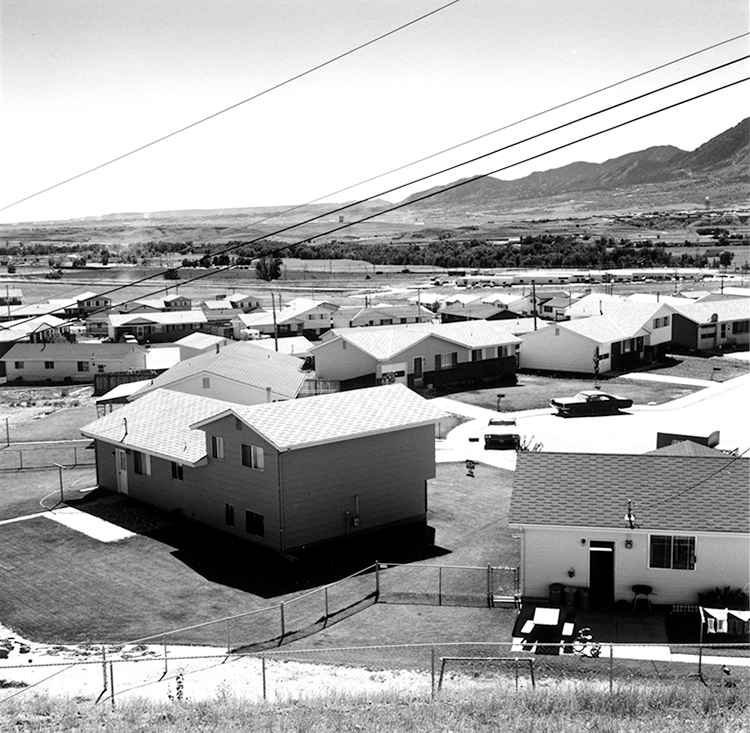
Colorado Springs, Colorado by Robert Adams, 1968–1971. Courtesy of the artist and Matthew Marks Gallery, New York. Image courtesy Fraenkel Gallery, San Francisco and Matthew Marks Gallery, New York.
Image Building, which made its debut at the Parrish Art Museum in Water Mill, New York, this spring, surveys nearly ninety years of architectural photography, from the 1930s to today, through sixty objects, most of them pictures. It’s a roll-call of familiar names—Abbott, Stoller, Baltz, Sugimoto, Gursky—but isn’t catechismal. “I wanted [Image Building] to [be] this sort of multi-layered experience, one that would be very subjective, very visceral, very aesthetic,” says curator Therese Lichtenstein. She organized it in a way that enables visitors to “move back and forth between the past and the present and across cultures and across periods.”
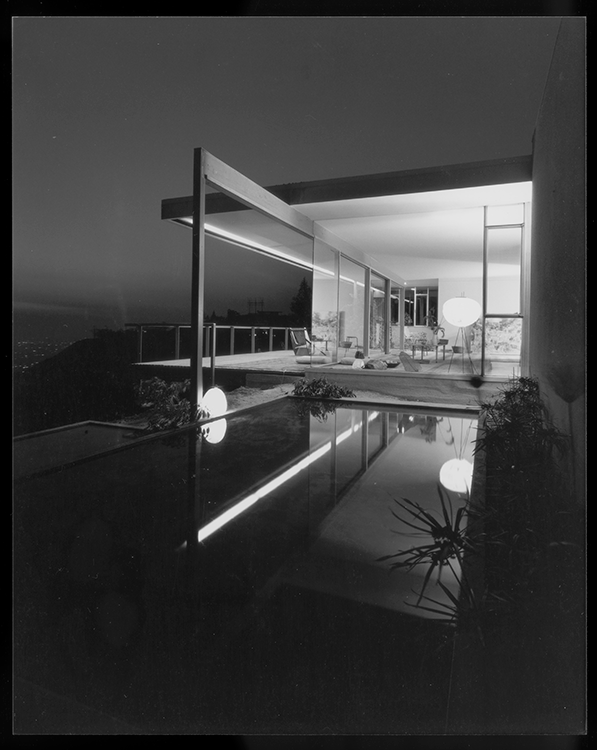
Chuey House (Los Angeles, Calif.) by Julius Shulman, 1956. Julius Shulman Photography Archive, Getty Research Institute, Los Angeles, 2004.R.10.
The show, divided into thematic sections, is far-reaching in scope, and sometimes feels a touch chaotic. In the section “Domestic Spaces,” Shulman’s trademark photos of Case Study Houses—all ebullient, diving perpendiculars—are allowed to clash with Robert Adams’s and Lewis Baltz’s deadpan depictions of suburban sprawl. The battle of ideologies plays out next to the innocuous, emotive work of Luigi Ghirri, which feels like an innocent bystander caught in the crossfire of the structures pictured by Adams and Baltz. What we see are mostly single-family homes, hence the title of the section, but the photographers approached them with such very different goals.
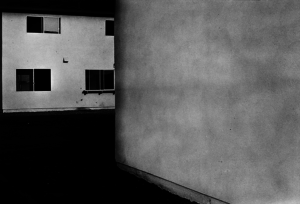
Tract House #6 by Lewis Baltz, 1971. George Eastman Museum, Rochester, New York. Image courtesy Estate of Lewis Baltz and Gallery Luisotti, Santa Monica.
Things are similarly complex in the other two sections, “Cityscapes,” and “Public Places.” Berenice Abbott’s nighttime New York, along with Ezra Stoller’s and Balthazar Korab’s portraits of Ludwig Mies van der Rohe’s Seagram Building and Eero Saarinen’s TWA Terminal, are thrown into the mix with the work of blue-chip contemporary art photographers of the Düsseldorf School. Ed Ruscha’s anemic Every Building on the Sunset Strip (1966) is stuck in for good measure. Image Building is a wonderful survey of photography’s biggest hits that happen to have buildings in them, but how to make sense of it all?
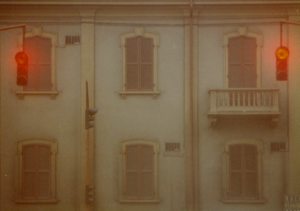
Reggio Emilia by Luigi Ghirri, 1973. Collection of Ted and Mary Jo Shen, New York. Image courtesy Matthew Marks Gallery, New York.
Despite Lichtenstein’s hope that the show would be something of an associative free-for-all, to really wrap one’s head around the work on view it helps to know a little bit about how architecture and photography got to be such good friends. Up until the mid-twentieth century, architecture was published and promoted almost exclusively through hand-renderings—some of them, such as those by Hugh Ferriss and Jules Guerin, works of art in their own right—not photographs. At first, this was a matter of tradition, as well as a technical issue. Before halftone printing was developed in the 1890s, it was impossible to print photographs and text side by side. But what really hitched photography to architecture was the modern movement. How better to picture “machines for living,” in Le Corbusier’s words, than with another machine? It quickly became essential for modern architects to find themselves photographer attachés: for Corbu it was Marius Gravot, for J. J. P. Oud Evert van Ojen, for the International Style builders it was Korab.
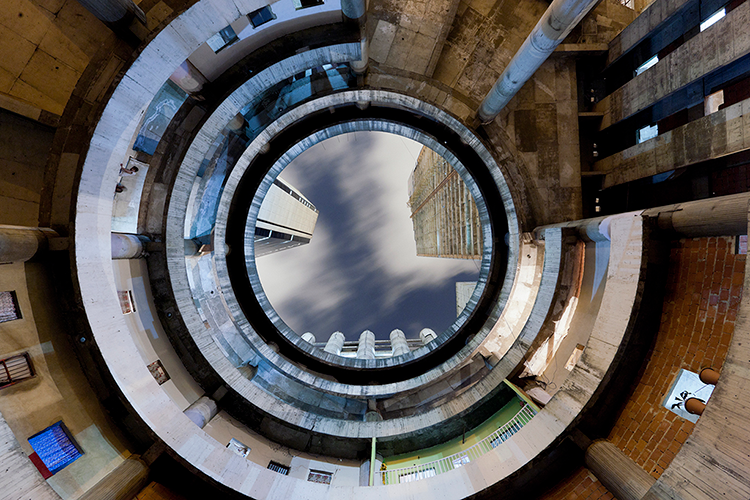
Torre David #2 by Iwan Baan, 2011. Courtesy the artist and Moskowitz Bayse, Los Angeles.
It is modernism—its ideology and dissemination—that knits Image Building together, and the photographers whose work is on view are either attracted to or repelled by it. Perhaps nowhere is this dynamic more apparent than in the recurring motif of a spiral. It first appears in “Domestic Spaces” on the cover of an old issue of Arts & Architecture in a vitrine: a swirling concrete parking ramp in a photograph by Shulman. To a modernism lover, the motif might evoke the perfect proportions of a nautilus shell or the concentric rings of angels in Gustave Doré’s illustrations for The Divine Comedy. But in a visual analogue hung in “Public Spaces,” Iwan Baan’s Torre David #2 (2011), showing an unfinished South American skyscraper commandeered by squatters fleeing life in the favela, the form takes on a decidedly different feel, one that’s anything but sublime. Gursky’s Shanghai (2000), reproduced in the catalogue that accompanies the exhibition, shows an anonymous Asian atrium’s endless stack of curved floors. It’s downright sinister, like the wall of a urine-colored whirlpool.
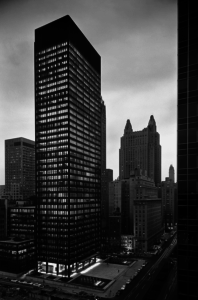
Seagram Building, Mies van der Rohe with Philip Johnson, New York, NY by Ezra Stoller, 1958. Courtesy Yossi Milo Gallery, New York.
While it’s true that many mid-century photographers were champions of modernism, many of those who came later were deeply skeptical of it, and dividing the work on view into polarizing buckets can only shed so much light. For one, much of the earlier work on view was done commercially (Shulman, for instance, bluntly described himself as a “merchandiser”), whereas much of the later photography was made with artistic ambitions. The contrast is made plain in the section “Cityscapes,” where Stoller’s and Samuel H. Gottscho’s builders-commissioned photographs of the indomitable-looking Seagram Building, Notre Dame du Haut, and Rockefeller Center hang next to Hiroshi Sugimoto’s contemporary pictures of the same subjects. The same subjects, but different: For his series of large-scale gelatin silver prints, Sugimoto pushed his 8 by 10 view camera totally out of focus. The buildings in his photos look like they’re evanescing. Is it a coincidence that the series was made at the turn of the twenty-first century, when the perception of the United States itself as indomitable was changing (a photograph of World Trade Center Towers 1 and 2, not included in the exhibition, is also part of the series)? Thomas Ruff’s pictures of other Mies buildings, hung nearby, have a similar ambience. They were made by colorizing archival images from New York’s Museum of Modern Art and applying a motion blur. They seem to show modernism speeding into the past . . . or modernism as seen from the window of a speeding car.
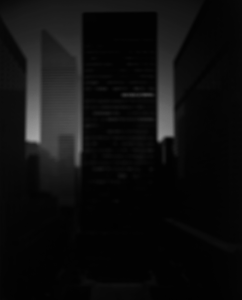
Seagram Building by Hiroshi Sugimoto, 1997. Courtesy the artist. Image courtesy Fraenkel Gallery, San Francisco/ Marian Goodman Gallery, New York.
Interestingly, if you were to put all the pictures in the show onto a timeline, you’d get something like the stylistic history of photography running in reverse. Ruscha and the mid-century commercial photographers are exemplars of the “straight photography” approach that gained currency after World War I. But in work that chronologically comes later, such as in Sugimoto’s and Ruff’s, cold, sharp clarity is gone and an allegorical impulse that would be at home in early twentieth-century pictorialism is back. It isn’t only in terms of style that things appear to go backwards. In some of the largest, most striking, and contemporary works on view—by James Casebere and Thomas Demand—the built environment has devolved into latency. Casebere’s owl’s-eye view of what appears to be a moonlit subdivision, Landscape with Houses (Dutchess County, NY) #2 (2009), is in fact nothing but a table-size model. What’s shown is not buildings as they are, but buildings as they might be.
Does architecture itself get lost in the shuffle of all this gorgeous imagery? In a way, architecture doesn’t even factor into the equation. “The image, the double, splits what it doubles,” Jacques Derrida once wrote. Pictures are treacherous. Image Building is a reminder.
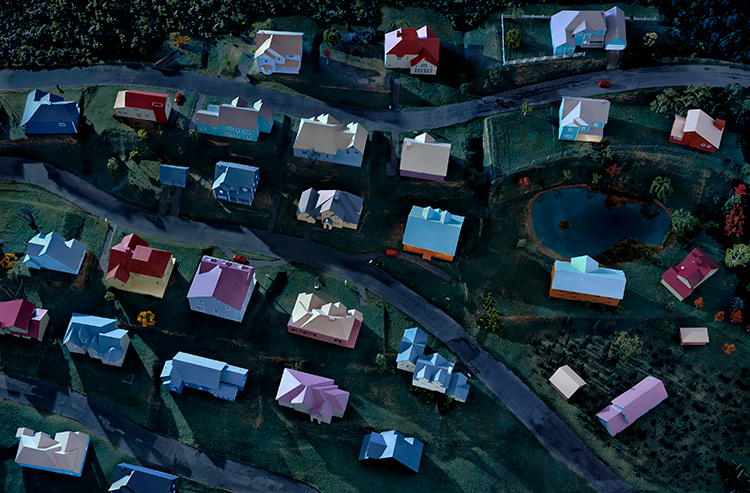
Landscape with Houses (Dutchess County, NY) #2 by James Casebere, 2009. Collection of Marcia Dunn and Jonathan Sobel, New York. Image courtesy the artist and Sean Kelly, New York.


